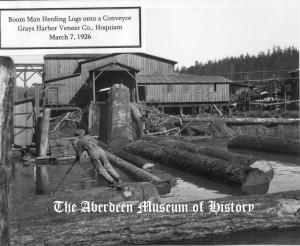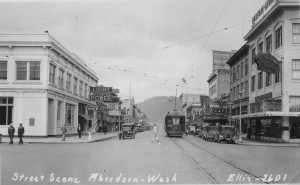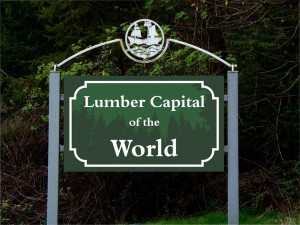It is said that lumber makes the world go round; and looking at the history of Aberdeen, it is hard to disagree. Here on the eastern edge of Grays Harbor, our small town holds lumber records that may never be broken. We built the state and influenced trade up and down the west coast and around the world.
Once the envy of all other towns in the Pacific Northwest, Aberdeen is now embracing its lumber roots and showing them off to the carloads of visitors entering town or heading out to the coast, rainforest and magnificent wilderness beauty of the region.

Lumber has always been a part of Aberdeen, and now, thanks to Aberdeen City Council Member Kathi Hoder and local businessman Tim Quigg, a new sign adorns the entrance to town along Highway 12. Reading “Lumber Capital of the World,” the new sign hopes to educate and celebrate Aberdeen’s history and culture. Presented by Hoder and Quigg as a gift to Mayor Simpson for his contributions to the city, the sign sits just a few feet behind the “Welcome to Aberdeen” that also reads “Come As You Are.”
The sign isn’t meant to shift culture away from the legacy of Nirvana, but instead help show a relationship between the region, music and town’s incredible past. According to Quigg, the new sign was constructed by GM Nameplate from Seattle, which also built the welcome to first “Welcome to Aberdeen” sign along Highway 12. Don Root, the CEO and Chairman of the company also helped give the new counterweight to the Wishkah Street Bridge.
Quigg knows a thing or two about the lumber industry and Grays Harbor. His family has been around the region for generations and is a wealth of historical information for the lumber industry of Grays Harbor. He is also working to create a Nirvana museum, as well as providing the region with modified containers to use as shelters to help those less fortunate.
The Quiggs are like many families in the Grays Harbor region. While they arrived in town after the great San Francisco earthquake, many of us came later but found the same spirit and pride in the area. Quigg is a humble man and quietly talks about his roots in the logging industry. However, when you get him talking about Aberdeen and what our town means to the world, his humility fades, replaced with a hometown pride that comes from growing up and defending the reputation of the harbor.

“I think there are many defining elements of Aberdeen, but two of the biggest are Nirvana and being the Lumber Capital of the World,” explained Quigg. “What that means is that no matter where you are in the world, they know Kurt Cobain and they know Aberdeen.”
The two are linked, and the bond is undeniable. If it wasn’t for lumber, nobody would be here in town. Without people, Kurt Cobain would have grown up elsewhere, possibly never tapping into the emotions he felt that helped create his music. Without our trees and his music, Aberdeen would be known as nothing more than a small town on Grays Harbor.
“Timber is the one thing that drives everything, and that is why we are can correctly call ourselves the lumber capital of the world,” said Quigg. “We provided the trees to the world that created everything. If we did not have lumber, we wouldn’t be here.”
When the British first explored the region we now call Grays Harbor, they are rumored to have said that whoever controls these forests will rule the world. Within 130 years of the initial “discovery” of Grays Harbor by Captain Robert Gray, Aberdeen become the largest lumber town in the world. With direct access to the Pacific Ocean, Aberdeen was once said to be the busiest port on America’s west coast.

The trees that became timber led to the population boom that brought people to our rainy city from around the world. In the later years, as the timber industry waned, the rain became an excuse to hang out, form bands and experiment with music in garages and spare rooms. It led to dark thoughts and creative lyrics that eventually represented an entire generation.
“In 1926, Grays Harbor exported 1.4 billion MBF of lumber,” noted Quigg. “That is a world record that has stood for 90 years!”
The new sign at the start of town helps remind and show off Aberdeen’s rich cultural and industrial history. More than just words, the sign exemplifies our pride for what the region once was, and what we hope the region can once again become. While the needs of the logging industry have shifted away from Grays Harbor, the region is on the verge of another renaissance of industry. As we shift from lumber, it is important to remember where we came from and what once made this town the jewel of the West Coast.
Welcome to Aberdeen, the world’s lumber capital of the world. Come as you are.













































